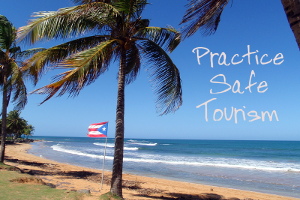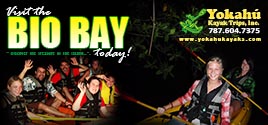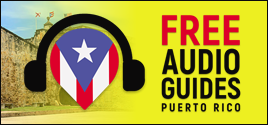Personal Safety Considerations

One of the last things you want to do on your vacation is get hurt, get sick, break something, get robbed, end up in the hospital or worse.
There are lots of fun activities to do in life and in Puerto Rico, and almost all of them have some measure of inherent risk and danger — sunburn, diarrhea, dehydration, slipping and cracking a bone, infections, getting lost, drowning, dying …
None of those sound like fun or how you want to remember your vacation.
No one or no thing can prepare you for every situation that might arise while you are traveling, or at home for that matter. But most of those unpleasant situations can be avoided with a little advance planning and a simple dose of common sense.
Be honest with yourself about what you are physically and emotionally capable of doing, what equipment you have (or lack) for an activity, and/or what level of risk you are willing to accept.
Just because an activity sounds or looks fun, safe or easy doesn’t mean that it will be. Just because someone else did something and did not get hurt, does not mean that it is safe and that you should try to do it yourself.
If Everyone Else Jumped Off a Bridge …
Remember the old saying "if everyone jumped off a bridge, would you"? This applies at home as well as when you travel. Don’t assume you should do something just because someone else did it — only use other people’s experiences and opinions as a suggestion, then make your own personal decision. Even some activities that you have done at home may become riskier on vacation — because you are in an unfamiliar place, maybe the equipment is just a little bit different, or maybe want to explore/experience just a "little bit more".
You are responsible for yourself. No one is making you do anything. If you choose to do something and it turns out badly for you, you have no one to blame but yourself.
Stuff We Do & Write About for Our Blog
We have obviously participated in a lot of different and extreme types of activities here in Puerto Rico, as evidenced by some of the articles in our blog. Some of our excursions have been under the direct supervision of professionals with training and years of experience in the given activity. And many other of our excursions have been just us winging it — like a couple of Amazing Race or Survivor wannabes.
Some of the things we do have less risk, some have more risk, and a number of them have been downright stupid and dangerous. We accept those levels of risk for ourselves when deciding to do something.
We Write About Things that We Have Done Here in Puerto Rico. Period.
Our blog posts should not be taken as a recommendation that people should use a particular operator, do any activity or explore any location. Just because we’ve done something and written about it doesn’t mean that the activity is safe or smart for anyone (including ourselves!) to do.
We write about our experiences, the conditions we encountered, and the difficulty level of an activity based solely on our judgment. Our comments and viewpoints are shaped by our past experiences … what’s easy, commonplace or ho-hum for us might be difficult, scary, exhilarating, or even dangerous for someone else.
We write this blog just to share our experiences and information with others. If we suggest gear or other stuff to bring on an excursion, our suggestions are just some ideas of what we think may help on the trip. It should not be taken as an exhaustive list for your needs. You are responsible for making your own list of what you think you might need for any given activity.
It’s Personal
When you read our description of an activity, you have to take into account our level of fitness & experience, our willingness to accept risk, the level of supervision, and the weather and/or conditions on the day we did it. Those personal variables may be very different for you, or the weather and/or conditions may be very different on the day that you choose to do the same activity. We don’t take any responsibility for anyone but ourselves.
We’ve watched, in disbelief, as local kids & teens have jumped off of the bridge in the Condado. We’ve watched and filmed other locals in the rain forest diving off of rock ledges into natural pools 20 or 80 feet below. It looks fun, exhilarating, and they make it look easy. But it also looks scary and dangerous to us, and we’ve chosen to go with our guts and keep our feet planted firmly on the ground, despite their encouragement to ¡Tirese! (Jump!). If you do something, it is because you choose to do it on your own, not because you found out about it from us.
In the end, each person has to decide, on a personal level, if they’re cut out for an activity or if there is the possibility that they might end up in a situation that they are unable, or unwilling, to accept or deal with. Each and every person has to take personal responsibility for their own health and safety.
Things We Keep in Mind During Our Outings (aka Common Sense)
- Stay out of questionable areas and dark streets, especially if traveling alone. Don’t flash a lot of money or jewelry.
- Don’t leave valuables unattended at the beach or pool, or visible in an unattended car.
- Wash hands frequently, and use anti-bacterial wipes and/or hand sanitizer liberally.
- Don’t eat food that may be under-cooked, or that has been sitting at room temperature for an extended period of time.
- Observe and follow posted signs and warnings.
- Wear lots of sunscreen when outdoors, even if it’s an overcast day.
- Wear topical insect repellent with Deet.
- Drink lots of water to stay hydrated.
- Only participate in activities for which one is willing to take personal responsibility for the outcome. Assume responsibility for one’s self at all times, even on a paid, guided tour.
- Only participate in activities for which one is physically and emotionally able, and that have a level of inherent risk that one is willing to accept.
- Make sure to have (and understand how to operate) all of the proper equipment for an activity. This might include a helmet, personal flotation device or rappelling equipment, or something as simple as a rash guard, proper footwear, sunscreen or hat. Do the research/planning prior to all activities, and then use own judgment on what may be necessary.
- If going hiking, swimming or exploring anywhere, take ample water, some food, sunscreen, proper footwear, a cell phone, a compass, a GPS device, a map, a signaling device or other safety devices, and make sure that someone back at home knows the planned route and the expected return time.
- Research and know what are, and how to look out for, the local conditions and risks, such as flash floods in rivers, surf conditions and rip tides in the ocean, weather conditions, current local health and safety issues, poisonous plants and animals that may be in the area, among other things.
- A dangerous activity doesn’t suddenly become safe just because everyone else is doing it. Don’t be pressured into doing something that just doesn’t feel right. Use common sense. If that little voice inside your head says that you’re about to do something that might not be safe … you should probably stop and listen.
It’s true that we don’t always follow all of our own recommendations. But the other saying "do as I say, not as I do" applies here.
Above All Else …
Have fun. Be safe. Don’t be stupid.










